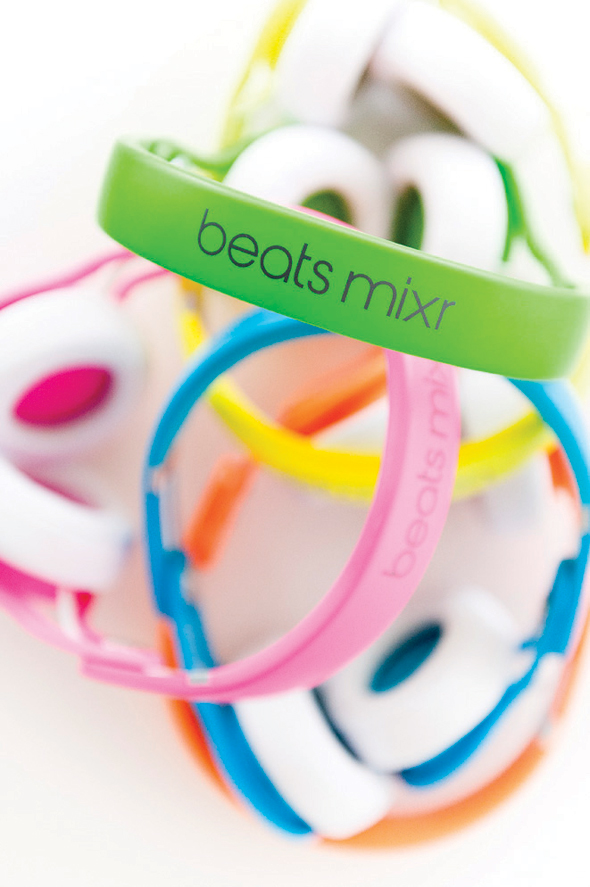
The scenario: A well-known rapper and producer who is passionate about improving the sound quality of audio products; an entrepreneur who sees a gap for a high performance audio brand; and one of the world’s most distinguished product designers. The response? Beats By Dr. Dre – a line of high-quality headphones that provide music enthusiasts with the ultimate sound experience.
You know you’re on to a good thing when you have the likes of Will.i.am, Lady Gaga, Gwen Stefani and P.Diddy endorsing a music product you have designed. This is the reality for industrial designer Robert Brunner, whose collaboration with Dr.Dre has shaped a worldwide phenomenon in the music industry. The partnership began seven years ago when Dre and best pal Jimmy Iovine (now Chairman and CEO of Beats Electronics) became interested in producing audio products; Dre sought to generate a platform for his music to be heard in its truest form. Brunner, who designed the original Apple PowerBook, was introduced to Dre through a mutual friend and there was an instant union between the three masterminds. “Strangely enough, I got on really well with Dre and Jimmy,” declares Brunner. “They always saw me as ‘talent’ and an ‘artist’, and there is a deep respect for the artist in music culture.” They invested in a business partnership and agreed to share the rewards if the product were successful. They developed Studio as the original headphone product, which took the world by storm. As a result, one of the world’s most powerful brands manifested: Beats By Dr. Dre.
Born Andre Romelle Young, Dr.Dre is a leading figure in today’s music business. He is a rap artist in his own right and has also produced albums for some of the world’s most legendary artists. Dre’s motivation for the venture came from a place of frustration with existing audio products. “In a very authentic way, Dre was passionate about developing the product,” says Brunner. “He’s a perfectionist and would spend a year working on a song, and then people would listen to it and couldn’t hear a lot of the detail he had worked so hard to capture.”
So what was it that made this product stand out so noticeably from its competitors? According to Brunner, there were three distinct features. Firstly, they redefined audio performance to be compatible with the modern world. Put simply by Brunner: “Tuning products for today’s music. For Dre’s music.” They made a collective decision to disregard what audiophiles assumed, and instead aimed to build products that were specifically designed and engineered to embody the raw emotion of rock and hip-hop music. Secondly, they reimagined the headphone. Brunner redesigned the headband structure to be cleaner, more modern and iconic. “When I looked at headphones,” he said, “they all followed the same basic structure and felt mechanical and busy. I wanted to do something much cleaner and iconic that could be worn as body art.” Today, Beats are the top selling line of headphones in the world (making over 1 billion U.S dollars in sales and owning 70 percent of the high-performance headphone market) and followers embrace the products as fashion accessories. Finally, Brunner maintains that the approach was holistic and the focus remained on being highly aspirational with attention to sound, culture and energy; it was always about being as much a movement as it was a brand.
For Jimmy Iovine, a widely connected music producer and chairman of Interscope Geffen A&M Records, the marketing strategy for Beats was straightforward: “A lot of people owe me a lot of favors.” As Brunner testifies, having pals in high places always helps the launch of a new product, “We have a lot of very visible friends who love to wear and use our products, which is an amazing catalyst for adoption.” Inevitably, first come the trend-setters, and then come the masses, and the Studio is now singly the most counterfeited product made today, something Brunner describes as “an unfortunate compliment.”

For Robert Brunner, a rare Silicon Valley native, his choice in career hasn’t always been received with open arms. His father, an accomplished engineer who invented the mechanics of the first disk drive, did not respect industrial designers and tried to persuade Robert to follow a different path. Needless to say, at the tender age of 24 when Robert designed a PC product for startup company Mindset, which was eventually taken into the permanent collection at MoMA in New York, his father’s sentiments swiftly changed.
Brunner’s focus for product design is less on the idea of growing technology, and more on the idea of what it does for people and how they are connected to it emotionally. “The thing I love about being involved in high technology is the way it keeps evolving and working deeper into our lives,” he says. “And at its best, it’s magic. It is a blast harnessing that magic in ways that delight and satisfy people.” Perhaps his success in the industry is linked to the fact that he was born and bred in the epicenter of the world for technology design. Or maybe the influence came from his parents and the creative home in which he grew up; always making things, perfecting things, visualizing them, and refining them. Whatever it was, something in Brunner clicked. He joined Apple in the late ‘80s soon after the failure of the original Mac Portable, and the first project he had was to define the next portable. After much deliberation, he produced a remarkable design, which has had a lasting impact – today, every notebook PC is based on it.
In 2007, Brunner formed his own company, Ammunition, which was founded on an ideal that the essence of ‘brands’ is the relationships that people have with products and services. “Our internal culture is centered around design as a powerful business tool built around defining these relationships with people, and bringing meaningful, wonderful, beautiful design to reality. We built a dual model here – we are not just here to shape your object, we’re here to shape your business and make you super successful,” says Brunner. Ammunition has worked with some of the biggest brands out there, including Barnes and Noble, Adobe, Williams Sonoma, Polaroid, Nike and Microsoft.
Jimmy Iovine depicts Robert as an extraordinary artist: “Dre and I are always drawn to talent like that. He showed us how to turn our ideas and emotions into a real thing, and his design has been instrumental to the success of Beats.” For Brunner, Beats is one of his proudest projects, predominantly because it has had a huge influence on society. Despite all of his successes and a string of awards under his belt, Brunner is less proud of the beautiful artifacts he has designed and more satisfied with products that have had an impact: “Winning an award is nice, but I feel better about seeing a kid wearing my headphones and enjoying them.”
Text by Heidi Mortlock
Photography by Liz Caruana

